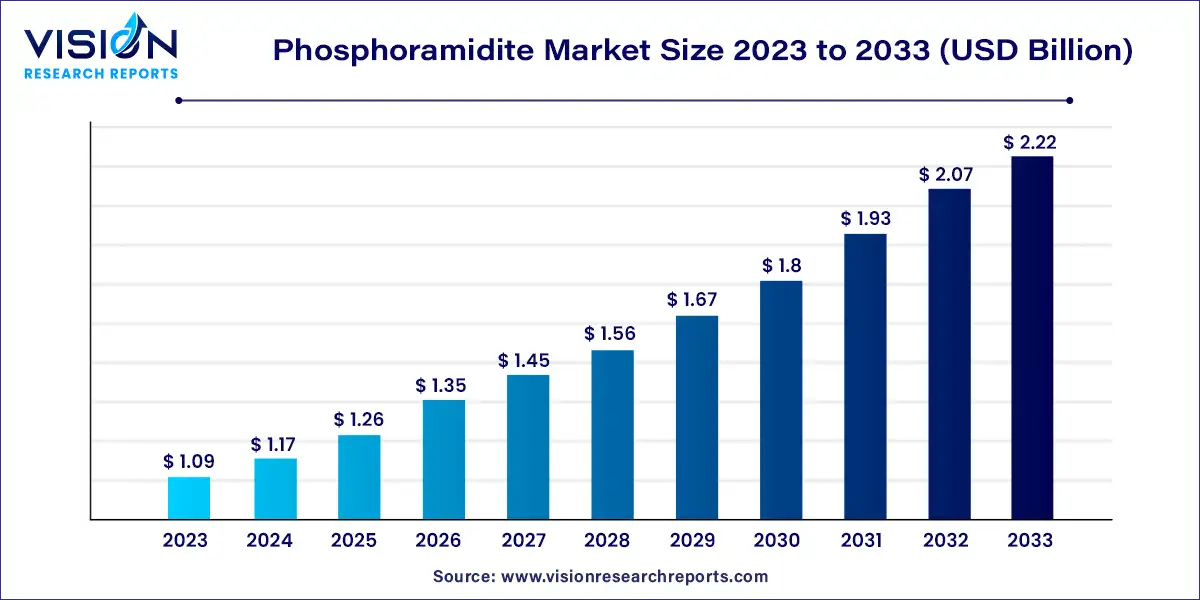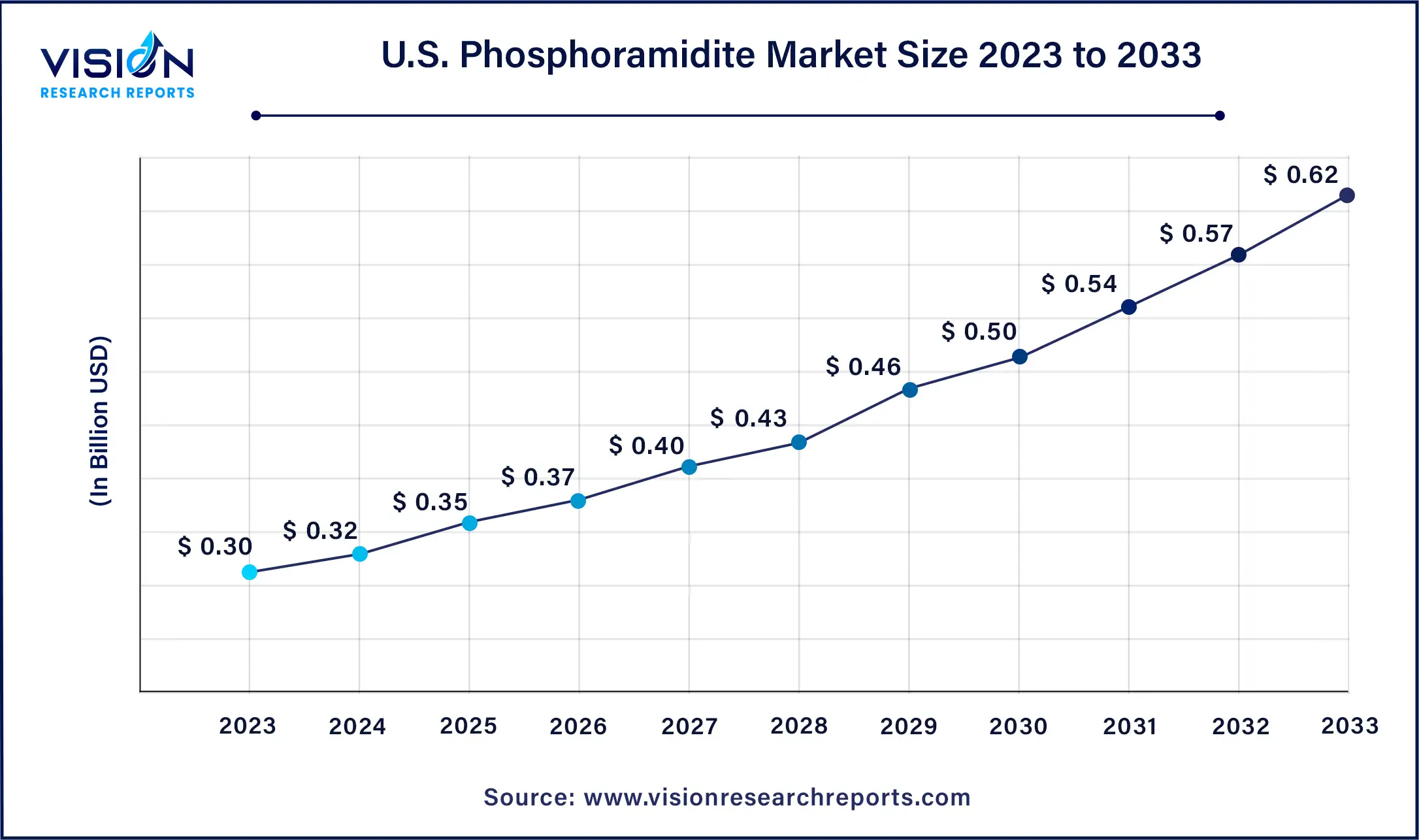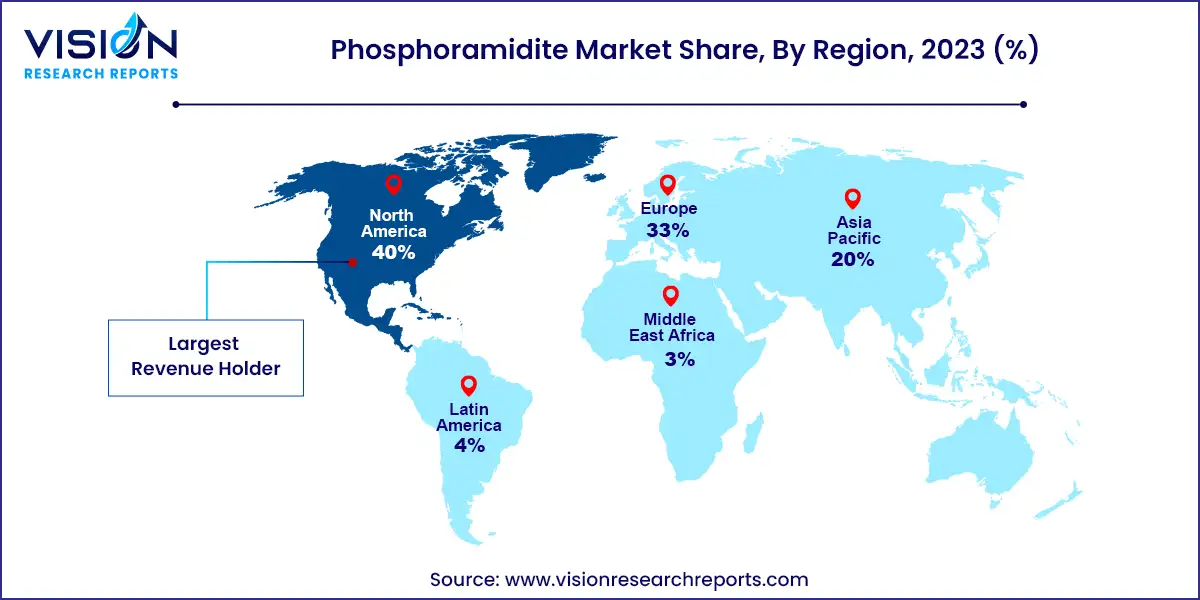The global phosphoramidite market size was estimated at around USD 1.09 billion in 2023 and it is projected to hit around USD 2.22 billion by 2033, growing at a CAGR of 7.39% from 2024 to 2033.

The phosphoramidite market is experiencing significant growth, driven by its pivotal role in the synthesis of oligonucleotides. These compounds are essential in various applications, including genetic research, diagnostics, therapeutics, and biotechnology. As advancements in genomics and molecular biology continue to surge, the demand for high-quality phosphoramidites is poised to rise correspondingly.
The growth of the phosphoramidite market is primarily driven by an increasing demand for oligonucleotide synthesis, essential in genetic research and therapeutic applications, significantly boosts market expansion. Advances in genomics and molecular biology, coupled with the widespread adoption of next-generation sequencing (NGS) and polymerase chain reaction (PCR) techniques, further amplify this demand. Additionally, the burgeoning biopharmaceutical sector, focused on developing antisense oligonucleotides, small interfering RNAs (siRNAs), and CRISPR-based therapies, drives substantial market growth. Lastly, increased investments in research and development, alongside supportive governmental policies, facilitate innovation and market development, positioning the phosphoramidite market for robust future growth.
The U.S. phosphoramidite market size was estimated at USD 0.30 billion in 2023 and it is expected to surpass around USD 0.62 billion by 2033, poised to grow at a CAGR of 7.52% from 2024 to 2033.

North America accounted for the largest market share of 40% in 2023 due to the increasing demand for oligonucleotides in research and development activities related to genetics and molecular biology. The U.S. is the largest market in North America, driven by the presence of major pharmaceutical and biotechnology companies, research institutions, and academic centers. Rising investments in drug discovery and development and technological advancements in DNA sequencing and synthesis are propelling the market in this region.

The Asia Pacific phosphoramidite market is projected to grow at the highest CAGR of 9.39% over the forecast period. Rapid industrialization and economic growth in countries like China, India, Japan, South Korea, and Singapore are driving demand across various industries, including pharmaceuticals and biotechnology. Significant investments in healthcare infrastructure, pharmaceutical research, and life sciences by governments and private companies are boosting the demand for phosphoramidites. The region's growing population and rising urbanization drive healthcare service demand, leading to increased pharmaceutical production and research activities, further boosting market growth.
The DNA phosphoramidites segment dominated the market in 2023, holding a revenue share of 37%. This type of phosphoramidite is widely used for producing DNA oligonucleotides, which are short DNA sequences employed in various applications, such as gene synthesis, PCR, and DNA sequencing. The growing demand for DNA oligonucleotides in fields like research, diagnostics, and therapeutics has significantly driven the growth of this segment. Companies are expanding their market presence through initiatives such as expansions, collaborations, and partnerships. For instance, in October 2023, Integrated DNA Technologies opened a new therapeutic oligonucleotide manufacturing facility in Iowa, U.S., spanning 41,000 square feet, enhancing customer support with advanced research and manufacturing capabilities and specialized expertise.
The RNA phosphoramidites segment is expected to grow at the fastest CAGR of 8.97% during the forecast period. RNA phosphoramidites are used to modify RNA oligonucleotides, tailoring their properties for specific applications. The rising need for modified RNA oligonucleotides in RNA therapeutics, functional genomics, and RNA-based diagnostics is set to propel this segment's growth. Additionally, advancements in RNA synthesis technologies have improved the efficiency and precision of producing modified RNA oligonucleotides, further driving this segment's expansion.
The pharmaceutical and biotechnology companies segment led the market with a 64% share in 2023 and is expected to grow at the fastest CAGR over the forecast period. This growth is attributed to the increasing demand for innovative drugs and therapies and the rising prevalence of chronic diseases such as cancer and diabetes. Many pharmaceutical and biotech companies are actively developing nucleic acid-based therapeutics, including antisense oligonucleotides, siRNA, and mRNA-based drugs, with phosphoramidites being essential reagents in their synthesis. This factor is anticipated to support the segment's growth in the coming years.
The academic and research institutes segment is also expected to register significant growth over the forecast period. These institutions are central to scientific research in fields like molecular biology, genetics, and drug discovery. As research expands in these areas, the demand for phosphoramidites as key reagents in nucleic acid synthesis and related experiments is expected to increase. Academic institutions also train future scientists and researchers, incorporating the latest techniques and technologies into curricula, which further drives the demand for phosphoramidites. Collaborations with pharmaceutical, biotechnology, and other industries are common, such as the March 2023 collaboration between CPI, AstraZeneca, Novartis, and The University of Manchester, aimed at enabling large-scale manufacture of oligonucleotides, where the university contributed its expertise in biocatalysis, a technique for oligonucleotide synthesis.
The drug discovery and development segment led the market with a 57% revenue share in 2023 and is expected to grow at the fastest CAGR from 2024 to 2033. The demand for phosphoramidites in this segment is driven by the focus on developing new drugs and therapies for various diseases. In drug discovery, researchers target specific genes or genetic sequences implicated in diseases. Phosphoramidites enable the synthesis of oligonucleotides tailored to these targets, allowing the development of targeted therapies with higher efficacy and fewer side effects compared to traditional small-molecule drugs. The increasing prevalence of chronic diseases and the need for effective treatments further drive demand in this segment.
The diagnostics development segment is expected to register significant growth over the forecast period. Phosphoramidites are crucial in synthesizing custom oligonucleotides for various diagnostic applications. The growing prevalence of infectious diseases and genetic disorders is driving the demand for accurate and sensitive diagnostic tests, supporting the market growth for phosphoramidites. These reagents enable the synthesis of oligonucleotide probes and primers for developing diagnostic assays that detect pathogens, identify genetic mutations, and characterize disease biomarkers. Advancements in diagnostic technologies, such as digital PCR, droplet digital PCR, and loop-mediated isothermal amplification, which require custom-designed oligonucleotides synthesized using phosphoramidites, offer enhanced sensitivity, specificity, and multiplexing capabilities for various diagnostic applications, further driving this segment's growth.
By Type
By Application
By End-use
By Region
Chapter 1. Introduction
1.1. Research Objective
1.2. Scope of the Study
1.3. Definition
Chapter 2. Research Methodology
2.1. Research Approach
2.2. Data Sources
2.3. Assumptions & Limitations
Chapter 3. Executive Summary
3.1. Market Snapshot
Chapter 4. Market Variables and Scope
4.1. Introduction
4.2. Market Classification and Scope
4.3. Industry Value Chain Analysis
4.3.1. Raw Material Procurement Analysis
4.3.2. Sales and Distribution Type Analysis
4.3.3. Downstream Buyer Analysis
Chapter 5. COVID 19 Impact on Phosphoramidite Market
5.1. COVID-19 Landscape: Phosphoramidite Industry Impact
5.2. COVID 19 - Impact Assessment for the Industry
5.3. COVID 19 Impact: Global Major Government Policy
5.4. Market Trends and Opportunities in the COVID-19 Landscape
Chapter 6. Market Dynamics Analysis and Trends
6.1. Market Dynamics
6.1.1. Market Drivers
6.1.2. Market Restraints
6.1.3. Market Opportunities
6.2. Porter’s Five Forces Analysis
6.2.1. Bargaining power of suppliers
6.2.2. Bargaining power of buyers
6.2.3. Threat of substitute
6.2.4. Threat of new entrants
6.2.5. Degree of competition
Chapter 7. Competitive Landscape
7.1.1. Company Market Share/Positioning Analysis
7.1.2. Key Strategies Adopted by Players
7.1.3. Vendor Landscape
7.1.3.1. List of Suppliers
7.1.3.2. List of Buyers
Chapter 8. Global Phosphoramidite Market, By Type
8.1. Phosphoramidite Market, by Type, 2024-2033
8.1.1 DNA Phosphoramidites
8.1.1.1. Market Revenue and Forecast (2021-2033)
8.1.2. RNA Phosphoramidites
8.1.2.1. Market Revenue and Forecast (2021-2033)
8.1.3. Labeled Phosphoramidites
8.1.3.1. Market Revenue and Forecast (2021-2033)
8.1.4. Modifier Phosphoramidites
8.1.4.1. Market Revenue and Forecast (2021-2033)
8.1.5. Others
8.1.5.1. Market Revenue and Forecast (2021-2033)
Chapter 9. Global Phosphoramidite Market, By Application
9.1. Phosphoramidite Market, by Application, 2024-2033
9.1.1. Drug Discovery & Development
9.1.1.1. Market Revenue and Forecast (2021-2033)
9.1.2. Diagnostics Development
9.1.2.1. Market Revenue and Forecast (2021-2033)
9.1.3. Others
9.1.3.1. Market Revenue and Forecast (2021-2033)
Chapter 10. Global Phosphoramidite Market, By End-use
10.1. Phosphoramidite Market, by End-use, 2024-2033
10.1.1. Pharmaceutical & Biotechnology Companies
10.1.1.1. Market Revenue and Forecast (2021-2033)
10.1.2. Academic & Research Institutes
10.1.2.1. Market Revenue and Forecast (2021-2033)
10.1.3. Others
10.1.3.1. Market Revenue and Forecast (2021-2033)
Chapter 11. Global Phosphoramidite Market, Regional Estimates and Trend Forecast
11.1. North America
11.1.1. Market Revenue and Forecast, by Type (2021-2033)
11.1.2. Market Revenue and Forecast, by Application (2021-2033)
11.1.3. Market Revenue and Forecast, by End-use (2021-2033)
11.1.4. U.S.
11.1.4.1. Market Revenue and Forecast, by Type (2021-2033)
11.1.4.2. Market Revenue and Forecast, by Application (2021-2033)
11.1.4.3. Market Revenue and Forecast, by End-use (2021-2033)
11.1.5. Rest of North America
11.1.5.1. Market Revenue and Forecast, by Type (2021-2033)
11.1.5.2. Market Revenue and Forecast, by Application (2021-2033)
11.1.5.3. Market Revenue and Forecast, by End-use (2021-2033)
11.2. Europe
11.2.1. Market Revenue and Forecast, by Type (2021-2033)
11.2.2. Market Revenue and Forecast, by Application (2021-2033)
11.2.3. Market Revenue and Forecast, by End-use (2021-2033)
11.2.4. UK
11.2.4.1. Market Revenue and Forecast, by Type (2021-2033)
11.2.4.2. Market Revenue and Forecast, by Application (2021-2033)
11.2.4.3. Market Revenue and Forecast, by End-use (2021-2033)
11.2.5. Germany
11.2.5.1. Market Revenue and Forecast, by Type (2021-2033)
11.2.5.2. Market Revenue and Forecast, by Application (2021-2033)
11.2.5.3. Market Revenue and Forecast, by End-use (2021-2033)
11.2.6. France
11.2.6.1. Market Revenue and Forecast, by Type (2021-2033)
11.2.6.2. Market Revenue and Forecast, by Application (2021-2033)
11.2.6.3. Market Revenue and Forecast, by End-use (2021-2033)
11.2.7. Rest of Europe
11.2.7.1. Market Revenue and Forecast, by Type (2021-2033)
11.2.7.2. Market Revenue and Forecast, by Application (2021-2033)
11.2.7.3. Market Revenue and Forecast, by End-use (2021-2033)
11.3. APAC
11.3.1. Market Revenue and Forecast, by Type (2021-2033)
11.3.2. Market Revenue and Forecast, by Application (2021-2033)
11.3.3. Market Revenue and Forecast, by End-use (2021-2033)
11.3.4. India
11.3.4.1. Market Revenue and Forecast, by Type (2021-2033)
11.3.4.2. Market Revenue and Forecast, by Application (2021-2033)
11.3.4.3. Market Revenue and Forecast, by End-use (2021-2033)
11.3.5. China
11.3.5.1. Market Revenue and Forecast, by Type (2021-2033)
11.3.5.2. Market Revenue and Forecast, by Application (2021-2033)
11.3.5.3. Market Revenue and Forecast, by End-use (2021-2033)
11.3.6. Japan
11.3.6.1. Market Revenue and Forecast, by Type (2021-2033)
11.3.6.2. Market Revenue and Forecast, by Application (2021-2033)
11.3.6.3. Market Revenue and Forecast, by End-use (2021-2033)
11.3.7. Rest of APAC
11.3.7.1. Market Revenue and Forecast, by Type (2021-2033)
11.3.7.2. Market Revenue and Forecast, by Application (2021-2033)
11.3.7.3. Market Revenue and Forecast, by End-use (2021-2033)
11.4. MEA
11.4.1. Market Revenue and Forecast, by Type (2021-2033)
11.4.2. Market Revenue and Forecast, by Application (2021-2033)
11.4.3. Market Revenue and Forecast, by End-use (2021-2033)
11.4.4. GCC
11.4.4.1. Market Revenue and Forecast, by Type (2021-2033)
11.4.4.2. Market Revenue and Forecast, by Application (2021-2033)
11.4.4.3. Market Revenue and Forecast, by End-use (2021-2033)
11.4.5. North Africa
11.4.5.1. Market Revenue and Forecast, by Type (2021-2033)
11.4.5.2. Market Revenue and Forecast, by Application (2021-2033)
11.4.5.3. Market Revenue and Forecast, by End-use (2021-2033)
11.4.6. South Africa
11.4.6.1. Market Revenue and Forecast, by Type (2021-2033)
11.4.6.2. Market Revenue and Forecast, by Application (2021-2033)
11.4.6.3. Market Revenue and Forecast, by End-use (2021-2033)
11.4.7. Rest of MEA
11.4.7.1. Market Revenue and Forecast, by Type (2021-2033)
11.4.7.2. Market Revenue and Forecast, by Application (2021-2033)
11.4.7.3. Market Revenue and Forecast, by End-use (2021-2033)
11.5. Latin America
11.5.1. Market Revenue and Forecast, by Type (2021-2033)
11.5.2. Market Revenue and Forecast, by Application (2021-2033)
11.5.3. Market Revenue and Forecast, by End-use (2021-2033)
11.5.4. Brazil
11.5.4.1. Market Revenue and Forecast, by Type (2021-2033)
11.5.4.2. Market Revenue and Forecast, by Application (2021-2033)
11.5.4.3. Market Revenue and Forecast, by End-use (2021-2033)
11.5.5. Rest of LATAM
11.5.5.1. Market Revenue and Forecast, by Type (2021-2033)
11.5.5.2. Market Revenue and Forecast, by Application (2021-2033)
11.5.5.3. Market Revenue and Forecast, by End-use (2021-2033)
Chapter 12. Company Profiles
12.1. BOC Sciences.
12.1.1. Company Overview
12.1.2. Product Offerings
12.1.3. Financial Performance
12.1.4. Recent Initiatives
12.2. Thermo Fisher Scientific Inc.
12.2.1. Company Overview
12.2.2. Product Offerings
12.2.3. Financial Performance
12.2.4. Recent Initiatives
12.3. Merck KGaA.
12.3.1. Company Overview
12.3.2. Product Offerings
12.3.3. Financial Performance
12.3.4. Recent Initiatives
12.4. Glen Research.
12.4.1. Company Overview
12.4.2. Product Offerings
12.4.3. Financial Performance
12.4.4. Recent Initiatives
12.5. LGC Biosearch Technologies.
12.5.1. Company Overview
12.5.2. Product Offerings
12.5.3. Financial Performance
12.5.4. Recent Initiatives
12.6. Biosynth
12.6.1. Company Overview
12.6.2. Product Offerings
12.6.3. Financial Performance
12.6.4. Recent Initiatives
12.7. BIONEER CORPORATION.
12.7.1. Company Overview
12.7.2. Product Offerings
12.7.3. Financial Performance
12.7.4. Recent Initiatives
12.8. QIAGEN
12.8.1. Company Overview
12.8.2. Product Offerings
12.8.3. Financial Performance
12.8.4. Recent Initiatives
12.9. PolyOrg, Inc.
12.9.1. Company Overview
12.9.2. Product Offerings
12.9.3. Financial Performance
12.9.4. Recent Initiatives
12.10. Lumiprobe Corporation
12.10.1. Company Overview
12.10.2. Product Offerings
12.10.3. Financial Performance
12.10.4. Recent Initiatives
Chapter 13. Research Methodology
13.1. Primary Research
13.2. Secondary Research
13.3. Assumptions
Chapter 14. Appendix
14.1. About Us
14.2. Glossary of Terms
 Cross-segment Market Size and Analysis for
Mentioned Segments
Cross-segment Market Size and Analysis for
Mentioned Segments
 Additional Company Profiles (Upto 5 With No Cost)
Additional Company Profiles (Upto 5 With No Cost)
 Additional Countries (Apart From Mentioned Countries)
Additional Countries (Apart From Mentioned Countries)
 Country/Region-specific Report
Country/Region-specific Report
 Go To Market Strategy
Go To Market Strategy
 Region Specific Market Dynamics
Region Specific Market Dynamics Region Level Market Share
Region Level Market Share Import Export Analysis
Import Export Analysis Production Analysis
Production Analysis Others
Others